The Andromedid meteor shower is normally a quiet affair, but very occasionally it puts on an intense show – which may happen on 2 December
By Abigail Beall
1 December 2023
A colour lithograph from 1877 depicts the Andromedid meteor shower of 1872
Antiqua Print Gallery/Alamy
A “lost” meteor shower may surprise skywatchers this weekend, astronomers have found, with the potential for as many as 200 meteors per hour on 2 December.
Read more
Earth is coated in ancient space dust that could be from the moon
The shower in question is the Andromedids, which is caused by dust and rocks left behind by the comet 3D/Biela entering Earth’s atmosphere and burning up. In most years the Andromedids barely produce more meteors than you might expect on an average evening of stargazing. But every so often, they kick off.
Advertisement
Records show that the Andromedids in 1872 and 1885 were particularly spectacular, with more than 1000 meteors in an hour. The last time the shower was active was in 2011, producing about 50 meteors per hour.
The reason for this inconsistency is the death of comet 3D/Biela. It was first spotted in 1772, and then again in the mid-1800s, when it had split into two pieces, but it has never been seen again. It seems to have disintegrated, which caused the particularly bright showers in the late 1800s.
But there is still a trail of debris and dust left behind by the comet’s original path, which Earth, on occasion, finds itself flying through. This happens rarely because the remaining material moves along orbits similar to the comet’s path. “It takes the meteoroids 6.7 years to orbit the sun,” says Robert Weryk at the University of Hawaiʻi at Mānoa. “Earth is rarely in the same place at the same time.”
